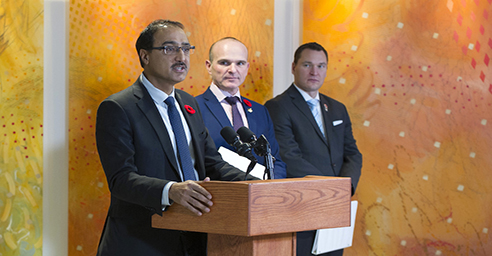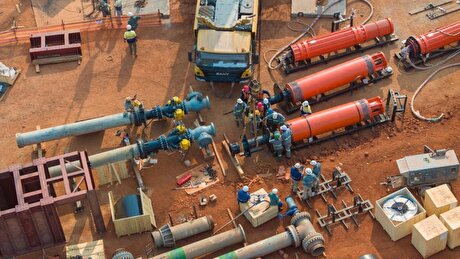
All but two Canadian provinces approve Minerals and Metals Plan


Among those key themes are raising Canadians' awareness of the importance of the minerals and metals sector, responding to ongoing and emerging challenges, and helping position the country as a major player in supplying minerals and metals that will power a cleaner global economy.
The CMMP was put together following a series of discussions with innovation experts, Indigenous Peoples, youth, non-governmental organizations, private companies, and industry associations.
One of the key themes is raising Canadians' awareness of the importance of the minerals and metals sector.
In a press release, the ministers listed six strategic areas their offices will be focusing on, namely economic development and competitiveness, advancing the participation of Indigenous peoples in mining projects, protecting the environment, incorporating world-leading science and technology into the industry, guaranteeing sustainable development for communities nearby mining projects, and sharpening Canada’s competitive edge in the global stage.
According to the statement, the specific actions that will guide such an overarching strategy are to be discussed at the Energy and Mines Ministers' Conference that will take place in July 2019.
“In a world increasingly looking for sustainably and responsibly sourced mineral products, Canada is unmatched. As global demand for sustainably developed resources grows, Canada must continue to capitalize on its natural and human advantage to ensure our competitiveness in global markets,” Amarjeet Sohi, the Federal Minister of Natural Resources, said in the media brief.
Sohi emphasized the contributions of the mineral sector to the country’s economy by stating that, for example, the production of some 60 minerals and metals at 200 active mines and 7,000 pits and quarries in Canada generated approximately $44 billion in 2017.
The minister also highlighted the fact that the minerals sector generates 634,000 direct and indirect jobs in rural, urban and remote regions, including 16,500 jobs for Indigenous peoples.
Two provinces vote down the plan
Despite the good intentions of the initiative, Ontario and Saskatchewan say that it falls short in growing Canada’s reputation as a world leader.
“We believe this plan needed to specifically address economic and competitiveness challenges and send a strong message to investors around the world that Canada is prepared to take real action to support our mining sector. Unfortunately, this plan does neither. As such, Ontario and Saskatchewan do not endorse the CMMP,” Greg Rickford, Ontario’s Minister of Energy, Northern Development and Mines, and Bronwyn Eyre, Saskatchewan’s Minister of Energy and Resources, said in a media statement.
According to Rickford and Eyre, the uranium industry in Saskatchewan and the steel and other metals sector in Ontario are facing tremendous challenges around trade and, in their view, it seems the federal government still has no plan to ensure that companies can access international markets in a transparent, stable, and effective fashion.
“That's why our governments are working to get our energy markets back to being sustainable and reliable,” the ministers’ release reads. “The people of Ontario and Saskatchewan can be certain that we will do everything in our power to protect our provinces’ industries from the job-killing carbon tax that the federal government seeks to impose on our provinces.”
Industry group reacts
In a more constructive tone, the Mining Association of Canada acknowledged that the country’s mining sector has been losing its competitive advantage. However, its representatives believe that the CMMP can address the issue.
In the view of the industry group, the measures outlined in the CMMP should enhance the competitiveness of the mining sector, as they draw a roadmap that will help increase strategic investments in infrastructure, support financing and taxation systems that back exploration, promote more efficient regulatory systems, and foster investing in Indigenous training initiatives and mining innovation.
“If all of Canada's governments take steps to put this plan into action, the competitive landscape for new mineral exploration and mining investment will be much improved,” Pierre Gratton, President and CEO of the Association, said in a media brief.


Trump weighs using $2 billion in CHIPS Act funding for critical minerals

Codelco cuts 2025 copper forecast after El Teniente mine collapse

Electra converts debt, launches $30M raise to jumpstart stalled cobalt refinery

Abcourt readies Sleeping Giant mill to pour first gold since 2014

Barrick’s Reko Diq in line for $410M ADB backing

Nevada army depot to serve as base for first US strategic minerals stockpile

Tailings could meet much of US critical mineral demand – study

Viridis unveils 200Mt initial reserve for Brazil rare earth project

SQM boosts lithium supply plans as prices flick higher

Energy Fuels soars on Vulcan Elements partnership

Northern Dynasty sticks to proposal in battle to lift Pebble mine veto

Giustra-backed mining firm teams up with informal miners in Colombia

Critical Metals signs agreement to supply rare earth to US government-funded facility

China extends rare earth controls to imported material

Galan Lithium proceeds with $13M financing for Argentina project

Silver price touches $39 as market weighs rate cut outlook

First Quantum drops plan to sell stakes in Zambia copper mines

Ivanhoe advances Kamoa dewatering plan, plans forecasts

Texas factory gives Chinese copper firm an edge in tariff war

Energy Fuels soars on Vulcan Elements partnership

Northern Dynasty sticks to proposal in battle to lift Pebble mine veto

Giustra-backed mining firm teams up with informal miners in Colombia

Critical Metals signs agreement to supply rare earth to US government-funded facility

China extends rare earth controls to imported material

Galan Lithium proceeds with $13M financing for Argentina project

Silver price touches $39 as market weighs rate cut outlook

First Quantum drops plan to sell stakes in Zambia copper mines

Ivanhoe advances Kamoa dewatering plan, plans forecasts


















